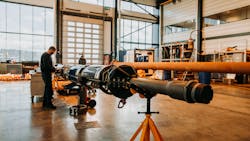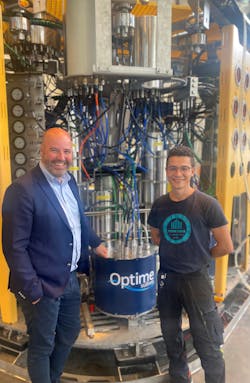Subsea intervention, completion systems speed operations on multiple Aker BP wells
Editor's note: This story first appeared in the September-October 2022 issue of Offshore magazine. Click here to view the full issue.
JEREMY BECKMAN * EDITOR, EUROPE
STANDARDIZATION OF EQUIPMENT became a mantra of the subsea industry in the 2010s, under pressure from operators to contain tieback costs. Today, the focus is shifting to simplifying subsea installations and reducing logistics, with the associated benefits for safety and the environment.
One of the quickest to adopt this mindset has been Aker BP, Norway’s second-largest offshore operator, currently implementing widespread subsea tiebacks across its production hubs in the North Sea and Norwegian Sea. Aside from encouraging drilling efficiency through its alliance with well engineering groups, the company has a track record of helping start-ups take their novel concepts offshore. One collaboration with Optime Subsea, which began in 2018, has led to the fast-track development and application of new subsea intervention and completions running systems on multiple wells on Aker BP’s fields. Optime Subsea is now looking to further develop its technologies for global take-up via an alliance with Halliburton.
The company, based in Notodden, eastern Norway, was formed in 2015 by a four-man team, all of whom had previously worked for FMC Technologies divisions in Houston, Rio de Janeiro and Norway. The previous summer, while attending the ONS conference in Stavanger, Optime’s CEO Jan-Fredrik Carlsen had listened to a presentation by Statoil (now Equinor), warning of the need for oil prices of at least $100/bbl for continued operations in the North Sea. At that point oil was $114/bbl, soon to plummet to $29/bbl. “I thought this was a good opportunity to challenge the prevalent technologies and methods of installation and maintenance of subsea fields, and also decommissioning,” he said.
“For some time, there had not been any developments in subsea – at GE, Aker Solutions and FMC the focus was on standardization to cut cost. No one was really looking into developing new methods or technologies to achieve the same outcome, but that is what often happens at large corporations. All four of us had the same dreams of starting a new subsea company, but to do things in a different way. We didn’t have any technology, concepts or products ready, we just knew about the challenges the industry saw. The price of developing subsea had increased over the past decade while the oil price was falling. We felt OK, we have a lot of experience. We were bold, so we decided to jump into a black hole without having solutions – but at the same time, we also did brainstorming and within six months had attracted our first investors.”
To generate income during this early start-up period, the team sold hours working as consultants to oil and gas operators, and this proved to be a good way of building a network. “But then, when you have developed your own solution, it has to be compliant with industry standards, ISO and quality requirements, all of which we had to go through. For our first two years we were working with ideas and then we combined our operation with an engineering company in the same city in Norway. That helped us attracted more investors and led to another merger, with Telemark Engineering, which was not in subsea, but had a team of clever guys.” In that period Optime went from 4 to 16 people. The company had started out using standardized components and products for equipment deliveries, winning its first major contract in 2018 from well intervention specialist AKOFS Offshore for a package including subsea winch/umbilical/controls equipment, “although that was not linked to our technologies.
“The same year we launched our first independently developed system, the SCILS (Subsea Controls & Intervention Light System): with this concept, we took all the topside components we saw in a traditional light intervention system and placed these on the seabed. Soon afterwards we secured our first contract for the SCILS with Aker BP.” The first deployment was from Odfjell Drilling’s semisubmersible Deepea Nordkapp for a two-well subsea P& campaign on the decommissioned Jette field in the North Sea, which had been developed as a tieback to the Jotun platform.
The SCILS is designed to simplify well access, interventions and workovers from any type of vessel. It can perform multiple subsea well control tasks and includes a closed loop hydraulic control system. By relocating hydraulic controls and power to the seabed, the SCILS eliminates the need for large, heavy equipment, or topside container, associated with by conventional Installation Workover Control Systems (IWOCS). This allows a substantial reduction in the size of the umbilical and installation reel, and also the long lead times, reliability issues, operational complexity and high costs often encountered with topside hydraulic umbilical systems. The SCILS occupies a subsea footprint of 3.7 x 2.5 x 3 m, and includes internal pumps, control modules and electric control jugs. The pumps, with a 3kW power rating, typically deliver 3 l/min at low pressure (345 bar) and 1 l/min in the high pressure (690) bar mode. Power and communication are provided through a 36-mm dia. umbilical cable from the surface.
The subsea hydraulic power unit (HPU), which can operate with multiple types of fluids and through various mechanical interfaces, has a built-in safety system compliant with industry standards for shut down (PSD/ESD), and can run either autonomously or through communication from various protocols. Batteries can be used to run the pump when needed to limit power requirements from existing production umbilicals.
For Jette, the application was connecting to a xmas tree, with the SCILS then engaging with the controls so that the tree could be removed. “The weight of the SCILS ranges from 3-7 metric tons,” Carlsen explained, “compared with 40-50 metric tons for a traditional system, which is also much heavier to mobilize. Typically, deployment takes 7-14 days for a conventional system whereas the SCILS can be delivered from the vessel to rig via one offshore lift, then mobilized from the rig within hours. Rather than run a large umbilical to interface with the xmas tree, the system is installed on the seafloor via a crane operation, interfacing directly to the tree. The footprint the SCILS occupies is also much smaller than with a conventional system and is mobilized within hours versus days for a traditional system.
Following the successful outcome of the initial contract, Aker BP awarded Optime a frame agreement a few months later in 2019 to work on subsea systems for an initial two years, followed by a further two-year extension. “In 2020, we performed our second successful operation with the SCILS for Aker BP at the Alvheim field, and up to today we have conducted 10 operations without any major issues or downtime. But we still needed to mobilize a topside/WOCS to deploy the tubing hanger.
“At the same time, we had been working on our Remotely Operated Controls System (ROCS) concept, designed to cut the mobilization time and cost of subsea completion operations by getting rid of all the traditional topside components, transferring them to the seabed. Our concept also removed the umbilical for operation of the tubing hanger running tool, making the system umbilical-less. And we took the control system and put it in the landing string itself. So although 2020 was a difficult year, with the pandemic, we also got our first contract from Aker BP to mature the ROCS very quickly to development, with the first run-out in late February 2021 for a production well on the Ærfugl field in the Norwegian Sea [a phased subsea development connected to the Skarv infrastructure].”
At headquarters in Notodden, Optime has an R&D area in the workshop. “Here all products, including hydraulics, pressure vessels etc, go into a hyperbaric test system, we qualify everything to 3,000 m water depth and to 300 bar. For the ROCS, we tested all the components in-house, followed by tests in the workshop, and we also obtained a tree and tubing hangar, allowing us to do a full system test (with interfaces), then go straight into operation.”
Normally when completing subsea wells, the tubing hanger is placed on top of the well head, acting as a seal towards the rest of the subsea well. The operation is typically controlled via a hydraulic umbilical connected to a topside hydraulic unit, with the umbilical clamped to the tubing for increased stability – a time-consuming task with attendant risks to personnel.
The ROCS is a universal landing string control system mounted around a traditional landing string drillpipe at the annular space inside the marine riser. It comprises a full redundant package of hydraulics, pumps, batteries, control modules and a data logger, with communications to the topside on rig or vessel performed wirelessly over an open protocol. The ROCS is designed to run landing string operations without an umbilical – this is said to increase the run speed, allowing for a reduction of personnel on the drillfloor by removing interfaces to the rig, with further benefits in reduced operational times and risk. The ROCS can be used to insert, seal/test and retrieve tubing hangers without an umbilical and to test downhole pressure and temperature sensors before installing a vertical xmas tree.
By early 2022, AkerBP had used the ROCS to install and retrieve tubing hangers of four vertical Aker Solutions and two horizontal Baker Hughes trees in operations on six wells on the Aerfugl, Alvheim and Gråsel fields, with no downtime reported. The system weighs around 5 metric tons, compared with 50 metric tons for a traditional set-up, according to Optime, and the total installation and operational time with a rig is much shorter (around three days) system. Associated CO2 emissions, including transportation and demobilization, are also said to be markedly lower. It occupies a footprint of 5-10 sq m, compared with 50-100 sq m for a traditional system, making it suitable for smaller vessels as well as rigs.
“For the first offshore operation on Ærfugl – a tubing hanger completion - it was cold and conditions were rough, but this also showed that the system can operate in bad weather,” Carlsen said. “One of our technicians is in a cabin on the rig, operating the system from his tablet – he can do that and test all the functions. With the traditional set-up, he would be exposed to wind, rain or snow, and having to operate in the rig’s red zone.
“For the initial run, first time out you typically do everything gently, as you want to reduce the risk – that’s the traditional approach. Aker BP expected 44 hours, we actually did it in 24 hours, and have since reduced the running time to 12 hours.” Optime claims that the much shorter good weather window needed makes planning more flexible, particularly for tasks in deeper waters or rougher sea states. As the system is prepared onshore and mobilized in a single basket, ready to run immediately offshore following delivery to the vessel or rig, operators can achieve further savings in vessel or rig days. “And unlike other light intervention and completion running systems, which are often engineered for specific subsea wells, both the ROCS and the SCILS can work with all wells with different trees, using the same equipment.”
“During a presentation at ONS 2022 in Stavanger, Aker BP stated that from its perspective, while ROCS significantly reduces capex and opex-related costs, the greatest benefits it provides are in HSE, i.e. safety of operations. The benefits are the true gamechanger.”
In May 2021, Optime formally entered a global strategic alliance with Halliburton. The aims include further development of the ROCS to work with Halliburton’s completion landing string services; jointly providing subsea intervention and workover control system services incorporating the SCILS; and umbilical-less operations and subsea controls for deepwater completions and interventions with improved operational efficiency and a smaller offshore footprint. The initial SCILS shipped to Halliburton in Houston was a 10K system, since upgraded to 12.5K.
“Optime has been working with a good group of North Sea operators, including Equinor and Aker BP,” Carlsen said, “but we want to take the technology worldwide, we’re a small company looking to compete with larger oganizations. Halliburton has a large share of the market in the Gulf of Mexico: the two companies will share the investments and also the profits.”
“Another issue, when switching the ROCS from one rig to another, is the different BOPs, each with different interfaces. So for the next generation system we are developing Panpipe, a joint between the tubing hanger and the ROCS itself, with all hydraulic lines inside the pipe, which can be cut or sheared as required. This joint, called the Simplified Landing String, allows Optime to be a completed service provider in this segment. There is no interface to the BOP, which means that Panpipe can move across to all types of BOP. Aker BP uses wired drill pipe, with the cable inside, and we employ that cable to communicate with the ROCS. But not all operators have wired pipe, so we are also developing a wireless version.” The next-generation ROCS should be ready in Q1 2023, with the added capability to run all tubing hangers in the industry, along with smart completions and downhole sensors.
“With Aker BP we have had success because they share our mindset, they want to simplify subsea. When you set out to challenge the way you do operations, you also need to challenge the existing technology, methods and way of doing those operations. Aker BP is proud of bringing new technology into operation – most other offshore operators are adapters, not first users. Now we have decided it’s time to mass-produce the ROCS to reach a wider audience, so we have committed to build 10 without having a contract in place, and this has already generated a lot of interest among international oil and gas operators.”
Optime has also developed a next-generation, wireless version of the SCILS which can operate without an umbilical, powered by batteries on the seabed, and a compatible subsea hydraulic pump. The system, known as eSCISLS, will be deployed this year offshore Norway. “We didn’t take a marinized topside pump and put it on the seabed, which would have added to the system’s weight. And we have developed software for topsides control and software for all-electric operations for both the ROCS and SCILS.”
About the Author
Jeremy Beckman
Editor, Europe
Jeremy Beckman has been Editor Europe, Offshore since 1992. Prior to joining Offshore he was a freelance journalist for eight years, working for a variety of electronics, computing and scientific journals in the UK. He regularly writes news columns on trends and events both in the NW Europe offshore region and globally. He also writes features on developments and technology in exploration and production.



